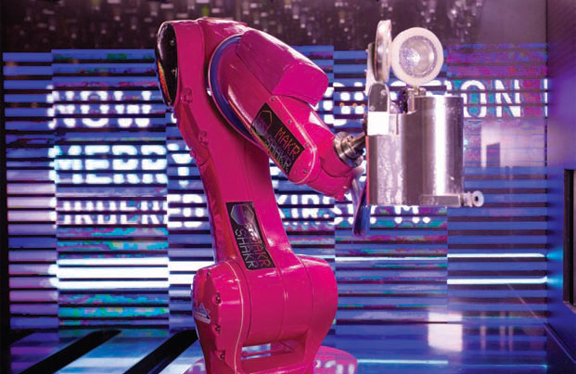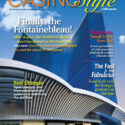
Hey, bartender” has become a loaded phrase, on a worldwide scale.
For most, it still denotes an employee scrambling to fill drink requests over the din of a noisy establishment. But today, it also means a sophisticated robot pouring precise, pre-programmed beverages. The phrase may also describe a hybrid: the human bartender aided by a mechanized device. Welcome to another world.
Bars now use apps, tablets, downloads, credit-card swipers and other interactive components, not merely at taverns but inside an increasing number of gaming facilities. And they’re fast.
The high-energy bar business meets the casino world at the crossroads of bottom line and bottoms up. As casinos break the player-tracking world down to small details, they join an industry with accounting holes bigger than the Grand Canyon.
The bar business by definition has long been vulnerable to waste. It faces dilemmas like an estimated 20 percent cost for not being fully stocked, and the loss of thousands of dollars for spillage, over-pours and giveaways. Cash can also be loosely transported, bundled with food revenue and not always reconciled with daily sales totals.
There’s also pressure. Drinks are poured hurriedly, often to crowds who feel the need to shout for a bartender’s attention. Try recalling multiple ingredients for hundreds of drinks at the snap of one’s fingers amid loud music, fast-paced orders and the pulse of excitement.
The perception that a bar makes money faster than it can be counted is only true if waste is eliminated. Casinos and their clubs embrace three new success terms: automate, calculate, celebrate.
The Employee View
As with most technological breakthroughs, bartenders view mechanical aids with ambivalence.
On the positive side, they have a partner able to produce more drinks. This increases tip opportunities from patrons who usually give something automatically.
Second, the devices reduce wait time and the chance that impatient customers will leave. There’s a mythical lore to automated bartending; George Thorogood, who proclaimed the need for “One Bourbon, One Scotch and One Beer” in a well-known song, might get them all now in 12 seconds.
On the flip side, automation monitors inventory. Every drink is measured, accounted for. There’s no option to make stronger drinks using more liquor to encourage tips. An unspoken status tier similar to a first-class airline passenger or frequent customer disappears. The phrase “on the house” vanishes. And the celebratory air of a drinking establishment faces bean-counting parameters like accuracy, accountability, speed and consistency.
Like most change-facing employees, a middle ground may be found. A creative bartender can gain conversational value in the automated device. He or she may even obtain management permission to dispense some free pours—extending the human arm, not the automated one, of player rewards.
There’s a negative side to the automation, however. In a recently threatened Las Vegas strike of culinary workers, the issue of bar automation became a rallying cry of workers fearful of losing their jobs. While the issue wasn’t directly addressed in the contract that averted the strike, it remains something that both union officials and casino executives will monitor.
Shake, Rattle and Roll
Come and see the show. Or be in the show.
Makr Shakr 3.0 provides a drink, not a shrink. The robotic device won’t have a human bartender’s conversational skills, but it will make a good cocktail. Novelty, not speed, is its stock in trade. Makr Shakr is already deployed in Las Vegas and Biloxi, with sales efforts aimed at wider distribution.
The device reproduces the actions of a bartender from the shaking of a martini to the muddling of a mojito. The robots don’t make mistakes, and they can mix doses to millimeter precision. Sixty spirits can be stored in bottles alongside syrups, sodas, juices, lemons and limes.
Patrons can employ this unusual bartender by downloading the app and launching the drink order on a phone from one of the bar’s tablet stations. Date of birth and drink selections are established and sent to the system.
What follows is the show. The robot washes off the shaker, dries it and places an empty cup on the counter. Ice is poured and the spirits, drawn from ceiling-mounted bottles with custom valves to ensure precise dispensing, are delivered. A garnish, like a lemon, can be added. The robotic arm with the water-tight lid then hits the visual hot spot, shaking and stirring the drink before pouring it. The shake and the stir prompt patron reactions, and should be accompanied by music.
This entertainment caught the eye of Las Vegas entrepreneur Rino Armeni, who discovered Makr Shakr on the internet and contacted the company in order to distribute what’s called the world’s first robotic bar.
“To me, the magic is in the sheer entertainment and attraction produced by the product,” Armeni says. “It’s not necessarily to replace bartenders. The whole area where the robot bar is situated is about 600 square feet. It is very easy to deploy because it comes in crates and is installed in about three days.”
Armeni says it will pour 653 drinks on a given night. Where is its appeal?
“When the customers come inside and sit in front of a tablet, the tablet has a menu for the choice of cocktails or also the ability to create their own cocktail,” he says. “The tablet will communicate with the robot as soon as the credit card is swiped. People seem to have a lot of fun with this, as there’s a lot of curiosity on how the robots respond to the request. It eliminates spoilage and over-spilling.”
The automated bar at the Miracle Mile stores at Planet Hollywood in Las Vegas is known as the “Tipsy Robot” bar. At the Hard Rock Casino Hotel in Biloxi, it’s called the “Robo Bar.”
Makr Shakr mixes automation, entertainment, flair and imagination. But it doesn’t come with ears to interpret one’s problems.
“I found this product to be extremely exciting for people who are always looking for an innovative way of entertaining themselves,” Armeni says.
“Obviously, the fact that they’re robots makes them able to produce perfect drinks every single time. They’re appreciative if you leave them a gratuity,” he laughs. “But all in all, it’s the technology that people appreciate, and that’s why they come to us, because we offer them something very unique.”
This is another score for Armeni, whose journey in Las Vegas began following a successful career with Marriott and the Walt Disney Corp., when he was named vice president of food and beverage for Caesars Palace. In 1994, he became executive director of marketing for Southern Wine & Spirits, the leading liquor distributor in Nevada, and later held various F&B positions with MGM Resorts.
As the head of Armeni Enterprises, he remains active in several food-and-beverage-related developments. In this project, he can give the public a fair shake.
The Evo Shuffle
Las Vegas-based Bar Evolution, with inspirational roots in Germany, has been true to its name.
Its bartender-support device, Evo (short for “evolution”), is used on a grand scale at nightclubs, sports stadiums, festivals and cruise ships. Evo is installed in Europe and served more than 2.7 million concert and festival attendees in the past year, according to Bar Evolution partner Bernd Witzany. The company wants to EVOlve further into the gaming world, with speed as its calling card.
“Evo mixes any cocktail of up to 40 ingredients in just three seconds, and one-liter pitchers in just over an amazing four seconds,” Witzany says. “A recently installed device dispensed nearly 90,000 cocktails flawlessly over a three-month period without failure or interruption, a testament to the device’s high quality. Evo can connect to any ingredient source.”
Witzany say Evo helps operators serve patrons exotic and popular cocktails more efficiently. It figures to turn the slash of reduced labor costs into the cash of a casino-owner windfall.
“Driven by new, patented Hydromix technology and paired with emerging management and control software, this innovative cocktail machine mixes perfect drinks with minimal operator effort,” he says. “It will become an establishment’s most efficient front-line asset by increasing sales volume, eliminating waste and greatly reducing labor costs.”
That should not threaten bartenders, he insists. Evo is a tool that supports them.
“A recent Evo case study validates the reported increase of 50 percent in server tips after the product was installed, due to the dramatically decreased wait times for drinks,” he says. “Customers have been waiting for this, and bartenders stand to benefit a lot as they can now focus more on those unique customer requests.
“We call it ‘cocktail automation with a human touch,’” he says. “This is not something that will replace a bartender’s job—it will help that person.”
Witzany cites another company report drawn from the Seven Feathers Casino in Oregon. Drinks were served to gaming floor guests in less than half the time, from 20 minutes down to less than nine, he says. The average drink tab was up 38 percent, servers could enter and pour their own drinks and the bar profit increased a whopping 148 percent in 10 months. This report says server tips rose nearly 44 percent; loss spillage and theft dropped by 75 percent; and material costs went down because Evo allows the purchase and use of larger containers.
The technology may also upgrade the atmosphere. Witzany says Evo’s aesthetic design and unique features add a dramatic flair to the environment. He touts a fascinating LED lighting feature giving Evo the ability to enhance mood and elegance. The integral processor-controlled LED lighting can be color-customized with an infinite number of lighting programs. The illumination also shows customers where to get a cocktail.
Evo was developed and patented in 2002 by an owner and operator of a nightclub in Munich, Germany, Witzany says. It is in its fourth iteration. It stands out in any club or bar, he says, and a design patent has been awarded for it. The company’s first version for the American market was approved almost two years ago, he says.
“It has been successfully installed in the United States, which has provided a solid and successful case study,” he says. “We anticipated certification for the next version of Evo by middle of June that would include some patented new features and refinements.
“We’ve designed our own self-contained and customized shipping-container solutions that can be deployed at any festivals throughout the world and be made operational within an hour,” he adds. “These highly refined units include complete, functional service bars complete with fold-out service counters, water, power, pumping systems and even eye-catching signage.”
Straight Up
Sometimes, the robot is… you.
Smartender, from the Smart Bar company of Henderson, Nevada, is a self-contained portable automated device that can pour hundreds of cocktail choices, from martinis and specialty drinks to juices and soft drinks at the touch of a button. Any authorized individual can use it on behalf of a company.
A dispense head ensures the accuracy of the pour within 1/20th of an ounce, officials say. The liquor drawer holds room for 16 bottles and 12 mixers with easy access to replace empty ones.
A bartender starts the process by tapping the device and inserting an unlock code. Player cards and room keys can also be swiped. A selection menu includes soft drinks, shots, martinis, tropical drinks, recently poured, user favorites, specialties and liquor/mixer to build one’s own drink.
Ice is taken from a dispenser, the glass put under the head, and voila! A drink in seconds, perfectly poured, recorded on a database and placed in a spreadsheet-type list of drink type, time of day and who used it.
Smartender has a feature telling the operator when a bottle is empty. It also connects to the mixer bay. And like an ideal employee, it can relocate. In this case, from room to room.
Used in stadiums, theaters, hotels and casinos, Smartender is among the family of products trumpeting large savings. Seemingly minor elements of the bartender-under-pressure scenario become costly. Smartender officials estimate a staggering loss for a simple overpour. Take the average price of a drink at $5. Multiply that by 15 cases of liquor. In one year, that can amount to more than $175,000 in losses—that’s for one-eighth of an ounce. Imagine a slightly more substantial overpour, not to mention giveaways. Double the loss for drinks costing $10.
There’s overpour, spillage and theft. Bar owners have long been wary of these problems, employing everything from mystery shoppers to security cameras to curb their impact. Now comes something just as useful to them, and, to some bartenders: another sales associate.
Throughout the industry, automated bar service is gaining momentum. The technology of tomorrow greets the patrons who wanted the drink yesterday, and it’s working. Pick the stylish presentation of a robot or the savvy engineering of a portable drink factory.
Either way, “Hey, bartender” now means a lot more.







